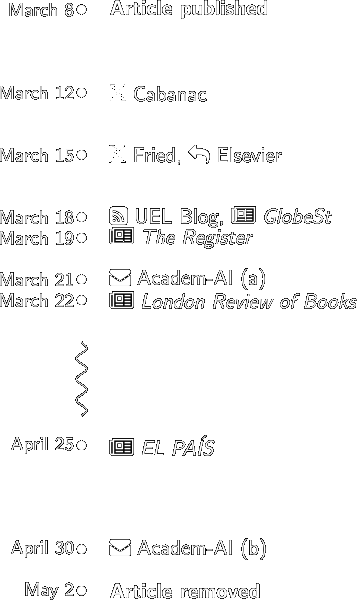gantt dateFormat YYYY-MM-DD axisFormat %b %Y todayMarker off Article published : milestone,2024-01-03,2024-01-03 AcAI contacts journal : milestone,2024-03-19,2024-03-19 Editor-in-Chief response—will investigate : milestone,2024-03-20,2024-03-20 Update—authors confirm use of AI tools, erratum to be published : milestone,2024-03-21,2024-03-21 AcAI request for update : milestone,2024-04-30,2024-04-30 Response—erratum being prepared for next available issue : milestone,2024-04-30 AcAI request for update : milestone,2024-08-12 Response—erratum being prepared for next available issue : milestone,2024-08-13 Erratum published : milestone,2024-09-04
Impact
May 14, 2025
Diana Kwon published an article in Nature entitled “Is it OK fro AI to write science papers? Nature survey researchers are split”, in which my comments are quoted.1 Read the article here:
April 24, 2025
Diana Kwon published an article in Nature entitled “Science sleuths flag hundreds of papers that use AI without disclosing it”, in which she discusses Academ-AI.2 Read the article here:
December 18, 2024
Stephanie M. Lee of The Chronicle of Higher Education published an article entitled “Scholars Are Supposed to Say When They Use AI. Do They?”, in which she discusses Academ-AI.3 Read the article here:
https://www.chronicle.com/article/scholars-are-supposed-to-say-when-they-use-ai-do-they
November 26, 2024
My analysis of the first 500 examples of suspected AI is now available as a preprint on arXiv.org.4 It has not yet been peer-reviewed.
Since generative artificial intelligence (AI) tools such as OpenAI’s ChatGPT became widely available, researchers have used them in the writing process. The consensus of the academic publishing community is that such usage must be declared in the published article. Academ-AI documents examples of suspected undeclared AI usage in the academic literature, discernible primarily due to the appearance in research papers of idiosyncratic verbiage characteristic of large language model (LLM)–based chatbots. This analysis of the first 500 examples collected reveals that the problem is widespread, penetrating the journals and conference proceedings of highly respected publishers. Undeclared AI seems to appear in journals with higher citation metrics and higher article processing charges (APCs), precisely those outlets that should theoretically have the resources and expertise to avoid such oversights. An extremely small minority of cases are corrected post publication, and the corrections are often insufficient to rectify the problem. The 500 examples analyzed here likely represent a small fraction of the undeclared AI present in the academic literature, much of which may be undetectable. Publishers must enforce their policies against undeclared AI usage in cases that are detectable; this is the best defense currently available to the academic publishing community against the proliferation of undisclosed AI.
October 24, 2024
Frances Jones of Research Professional News (Clarivate) published an article entitled “AI: ‘Scientific publishing is not prepared for this’”, for which she interviewed myself and other “sleuths”.5 Read the article here:
September 4, 2024
After several months and as many email exchanges, an erratum to Arsh et al. (2024) has been published.6,7 See the relevant page for details.
August 27, 2024
Academ-AI is honored to be recommended by Retraction Watch on their Papers and peer reviews with evidence of ChatGPT writing page.
May 2, 2024
An article8 by Bader et al., originally published on March 8, 2024, was finally removed from Radiology Case Reports after more than a month of discussion in newspapers, blogs, and social media, as well as my own correspondence with the journals’ editors. See the relevant page for details.

April 21, 2024
In my article “The case for universal artificial intelligence declaration on the precedent of conflict of interest,” published today, I argue that journals should require authors to declare that they have or have not used generative AI for each and every submission.9 I contend that authors will be less inclined to actively deceive journals concerning their use of generative AI than some have been to passively omit any declaration.
April 3, 2024
Today, my article “Suspected undeclared use of generative artificial intelligence” was published in Intelligent Pharmacy.10 The journal previously published an article by Verma et al., in which the telltale phrase “as of my last update” appeared.11 I addressed this article as well as explaining the significance of the undeclared AI problem.